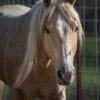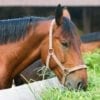How to Feed Your Horse in the Winter?
Feeding your horse in the winter is a difficult task. The temperatures begin to plummet in the winter, pasture grass stops growing and your rescue will depend on you to supply adequate nutrition. When temperatures drop below the “critical temperature” of 45 degrees Fahrenheit, your horse will require more energy to sustain its internal body heat. For every 1 degree below critical, your horse will need a relative 1 percent increase in consumable energy. Proper feeding in the winter months will revolve around three essential factors: water, fiber, and fundamental nutrients.
Tips for the Winter:
Water
A 1,000-pound adult horse in a relaxed environment will drink at least 8-12 gallons of clean water per day. Water intake will closely mirror the volume of feed consumed. Most rescue horses need roughly 48 fluid ounces (1.5 quarts) of water per pound of feed. Since horses can consume up to 3 percent of their body weight in a 24-hour period, your rescue should be downing at least 8 gallons of water on any given winter day. Water intake will increase if the adult horse is lactating, working, or in training; foals and growing horses will have a higher requirement as well.
The problem with water intake in winter is all about access. Horses won’t eat snow or drink frozen water unless they’re desperate. Decreased water intake may lead to digestive issues (notably, colic) and weight loss. Therefore, you want to provide water that’s considerably warmer than the air outside.
Fiber
Denied adequate fiber, horses will struggle to maintain body heat in winter. Most veterinarians recommend that your rescue horse consume at least 1.5 percent of its body weight in dry feed on a daily basis. The fiber contained in hay is essential for maintaining proper digestive function. It’s also important to provide high quality hay; otherwise, the horse will find other, not-so-healthy alternative sources such as wood and bedding. Contrary to popular opinion, grains like corn and wheat do not provide the right type of fiber to produce body heat from digestion. Grains may actually cause your rescue to shiver more than usual. Therefore, good quality hay is the most optimal feed to obtain fiber.
Nutrients
Weight loss in winter is commonly a result of poor nutrition within horses. Low-quality hay doesn’t contain enough calories or nutrients for proper digestion. As the horse increasingly relies on stored body fat, the pounds begin to melt away. Increasing the amount of hay won’t help, either. The failsafe remedy is to provide better-quality forage such as alfalfa hay (as opposed to grass hay). You can also supplement the rescue’s diet with alfalfa mix pellets and cubes. Chopped forage is very digestible and will furnish plenty of calories to prevent weight loss.
More Questions About Feeding your Horse in the Winter?
For more information on how to feed your horse in the winter or how you can rescue a horse in Montana, contact us at any of our two locations: Bozeman and Livingston. Always remember: Ride a horse. Safe a rescue.







